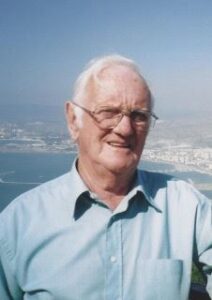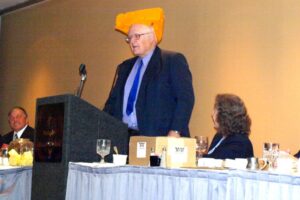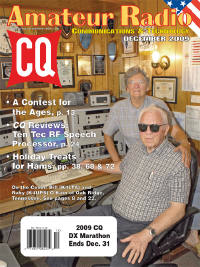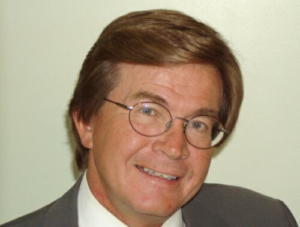Jack Moseley, G2CIW – 1923 – 2018
Obituary by Peter Windle, G8VG
 I first met Jack in 1948 when we were both living in Kent and although our working lives took us in different directions we had many excellent contacts during the years that followed.
I first met Jack in 1948 when we were both living in Kent and although our working lives took us in different directions we had many excellent contacts during the years that followed.
Jack was born on 11 November 1923 and at the age of 14 began his working life in his father’s bike shop. His interest in radio began after reading Practical Wireless and he went on to build a receiver that started him on the road to amateur radio. He first began to copy DX commercial broadcast stations but it was the amateur signals that really excited his interest. He soon met local amateurs, taught himself Morse code and went on to build all his own equipment.
In early 1939 he obtained his amateur licence 2CIW and his shack was in the garden shed. His amateur activities were cut short in September, 1939 on the outbreak of WWII when his transmitter was confiscated but his skill with Morse code, which included the teaching of Air Cadets, had been noted and he was approached by the authorities with a view to his joining the Radio Security Service (RSS) and becoming a Voluntary Interceptor (VI). He readily accepted the job and, after signing the Official Secrets Act would, when not working in the bike shop or on ARP duty, sit in his shack listening for German signals. Those evening and night time activities attracted the attention of neighbours who reported Jack to the local police. This was a common problem amongst the VIs, fortunately the police were aware that VIs were not enemy spies.
It soon became clear to the authorities that it was necessary to have full time RSS stations to copy the enemy signals and in 1941/42 Hanslope Park in Buckinghamshire became the first such station. Jack joined Hanslope Park in February 1942 where he met many other VIs including my father Bill Windle G8VG.
In 1943 Jack was sent to Gibraltar, a highly secure military base, where, toward the end of the war, he and a friend operated on the bands using the call EA7AB.
Shortly after his return to Hanslope in August 1945, where Betty had been working preparing Rockex encryption key tapes, she and Jack met at a dance. They were married on 12th April 1947 at Fenny Stratford, near Bletchley.
In the 1950’s Jack worked in Tangier where his daughter was born in 1952. Jack then had regular morning contacts with Maurice Handcocks, G5HN, and fellow Voluntary Interceptor, and asked Maurice to ‘phone his and Betty’s parents with news of the birth.
Jack was FOC member No.34 from 1955 to 2007 and for his last few years he lived, like many of us, in an apartment where his radio activity was severely limited but he still managed to put a signal on the bands using a stealth antenna. His last entry in his log was 17th June this year. He died in Gloucester Royal Hospital on Monday 5 November 2018.
Jack was appointed to the Ordre national de la Legion d`honneur by decree of 18 June 2018 which recognizes his engagement and steadfast involvement in Sigint activities during the Second World War.
RIP Jack you will be greatly missed.

Our very own Fred, K3ZO (being an ex-W9 from Wisconsin), having ventured into Bears country from Packerland, taunts the faithful at W9DXCC on September 15, 2012. Fred was lured to the event under false pretenses, having been invited to be the guest dinner speaker. And, having delivered a delightful rendering of W9 DX’ing history, Fred was promptly awarded the W9DXCC Amateur of the Year Award. Not to heap insult on injury, he was given a new TenTec RF Speech Processor. Horrors! Now what could he possibly want with that?
Beating the odds: A few of the changes in the 53 years that I have been K4LTA.
 One of the big changes for me is the logging of my contacts. At first in 1956, I would write down enough information in braille for my log and about once a week would transcribe it on loose leaf paper on my portable typewriter and put it in a binder.
One of the big changes for me is the logging of my contacts. At first in 1956, I would write down enough information in braille for my log and about once a week would transcribe it on loose leaf paper on my portable typewriter and put it in a binder.
Later, I was able to afford a separate typewriter for my hamshack and could type the log while I was making the contacts.
I later learned to enjoy contesting which posed a logging problem in that it took my wife, Ruby, now K4UPS, almost as long to edit my log as I spent in the contest.
Now with computer logging, I use TR log for contests and also my daily logging, Ruby can edit a contest log in 30 minutes and we can attach it to an e-mail headed to the contest committee.
Sending morse code is so much easier, too, progressing from a straight key that I used for the first year, to a semi-automatic bug for sending code for 3 years, then to an electronic keyer which had come into existance by that time, in the early 1960s. Now, if I am at all serious about a contest, I do the sending on a computer keyboard which takes a lot more work out of sending. I still prefer and use my electronic keyer and Bencher paddles for all my daily contacts.
My first equipment was a Globe Scout transmitter and Hammerlund HQ-129X receiver, followed by a Johnson Viking I and Hallicrafters SX-101 receiver before I got into transceivers. My first transciver was a National NCX-3, followed by a Swan 350, a Galaxy 5 transceiver, before my first Ten-Tec rig, a Triton 4. I was privileged to know Al Kahn, K4FW, personally and have had many visits with him while getting my Ten-Tec gear serviced at the factory.
My current equipment is 2 Omni 6 plus transceivers which are computer controlled, 2 Ten-Tec Hercules amplifiers, 2 automatic Ten-Tec tuners. I use these two identical set-ups operating SO2R in contests. I am still not very good at it after 5 years but can definitely work more stations with 2 radios than with only one.
Screen reading programs: I use Vocal-eyes and Window-eyes by GW micro, makes it possible for me to use the computers and read any portion of the screen that I select. Of course, the screen reading software works with voice synthicizers on the computers, I use Double Talk and DEC-talk.
Summary: My life has been greatly enriched through our wonderful hobby of amateur radio, most of all by the hundreds of wonderful friends that I have made world-wide. Of course, one of my greatest honours was becoming a member of FOC and 20 years later still enjoying the FOC activities and many personal friends I have made through our club. Other highlights have been to attend the FOC annual weekend in the UK on 5 different occasions and our 18 trips to the Caribbean since 1980 operating from 7 different islands.
Stuart’s Story – how an FOC Member Helps
by Dick Stein, K2ZR (FOC 1694)
 With the permission of Stuart’s mom Susan, I present the “rest of Stuart’s story” to my fellow FOC members. The first paragraph was Stuart’s mom’s response to my suggestion that I send K2ZR’s QSL card to Stuart. Please read on, you’ll be glad you did!
With the permission of Stuart’s mom Susan, I present the “rest of Stuart’s story” to my fellow FOC members. The first paragraph was Stuart’s mom’s response to my suggestion that I send K2ZR’s QSL card to Stuart. Please read on, you’ll be glad you did!
Quoting Stuart’s mom Susan: “Stuart would be thrilled to receive it. I am really not exaggerating how excited he was/is. He has a recording of all he did there on his hand held recorder and has listened to it over and over. He has also plotted out geographically each contact that he made. Our address follows at the end of this e-mail.
If you don’t mind, I’ll tell you a little bit of Stuart’s history. I’m biased, of course, but he’s overcome some overwhelming odds – he is a determined kid, that’s for sure! He is a surviving twin. He and his twin brother, Spencer, were born severely prematurely. Stuart weighed 1 pound 13 ounces at birth. His twin died at 9 days after major abdominal surgery for necrotizing enterocollitis (a perforation of the intestine), which Stuart was struck by 3 days later. He also had a major abdominal surgery during which he crashed. We were told he would most likely not survive even an hour after the surgery. In addition to his intestinal problems, he had major problems with his lungs and was on a ventilator for 45 days. He breathed on his own for the first time at day 45, which is also the very first time we were able to hold him. His stay in the neonatal intensive care unit was 100 days. He survived his prematurity but was left with asthma which at times has been life threatening, gross motor challenges, eye problems, severe migraines, an anaphylactic food allergy, and Asperger’s Syndrome (a high functioning form of autism characterized by perseverating focus on areas of interest – like ham radio!) Stuart is a bright, motivated, very sweet boy (again, I’m biased!) who is gifted in music (in addition to playing piano, violin, and guitar, he has perfect pitch, and has composed several pieces of music – one of which will be played by his school orchestra next December), math, computers – any thing technical and that lends itself to patterns (Morse Code!) He struggles socially, as he doesn’t have many peer related areas of interest. That is a big reason why it is so thrilling to see him make contact with you and other ham radio operators. He really longs for someone to share the high levels of enthusiasm he has for his areas of interest – right now, Morse Code is at the top of the list.
He was so disappointed that he is not going to make the July test date, but we’ll definitely get him there in August. Also, I know he wants to blog back to you about his field day. He read the story on my blackberry several times while we were driving him to camp. The first thing he did when he met his camp counselor was to tell him about his ham radio interest, about field day, and to play him the recording of his first Morse Code contact. Thank you again for making all of this possible.”

